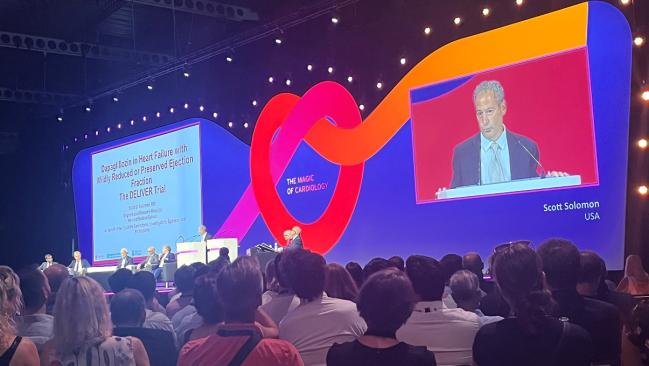DELIVER Results, Other Analyses Bolster SGLT2 Inhibitors Across HF Spectrum
These drugs improve outcomes and make patients feel better, Mariell Jessup says. “I think that’s a really important story.”

BARCELONA, Spain—(UPDATED) Full results of the DELIVER trial, flanked by several other analyses, demonstrate that the sodium-glucose cotransporter 2 (SGLT2) inhibitors provide benefits to patients with heart failure (HF) irrespective of ejection fraction.
The new data, presented here at the European Society of Cardiology Congress 2022 and published in 11 simultaneous publications across multiple journals, follow the release of top-line results in May.
The centerpiece is the main publication of DELIVER in the New England Journal of Medicine, which shows a significant reduction in the primary composite endpoint of cardiovascular death or worsening HF (unplanned hospitalization or urgent visit for HF)—over a median follow-up of 2.3 years, the rate was 16.4% among patients with mildly reduced or preserved ejection fraction (HFmrEF and HFpEF) treated with dapagliflozin (Farxiga/Forxiga; AstraZeneca) and 19.5% of those who received placebo (HR 0.82; 95% CI 0.73-0.92).
The effect did not differ between patients with ejection fractions above or below 60%. This is important because the EMPEROR-Preserved trial of another SGLT2 inhibitor, empagliflozin (Jardiance, Boehringer Ingelheim/Eli Lilly), though positive overall, suggested diminishing benefits at the higher end of LVEF.
The DELIVER results were joined in a Hot Line session Saturday by two pooled analyses that provide a broader perspective on the impact of SGLT2 inhibition. One combined the results of DAPA-HF, a trial of dapagliflozin in HF with reduced ejection fraction (HFrEF), and DELIVER to examine the drug’s impact across the entire range of ejection fractions, while another first combined DELIVER and EMPEROR-Preserved (in patients with mildly reduced or preserved EF) before adding information from DAPA-HF and EMPEROR-Reduced (in patients with HFrEF) and SOLOIST-WHF (in those with worsening HF).
Together, the data reflect two drugs—dapagliflozin and empagliflozin—with beneficial effects across a broad range of patients with HF, regardless of ejection fraction.
Commenting for TCTMD, Mariell Jessup, MD, chief science and medical officer of the American Heart Association, said, “In total, I think that these papers have all really strengthened the case for using SGLT2 inhibitors in all patients with heart failure.”
In total, I think that these papers have all really strengthened the case for using SGLT2 inhibitors in all patients with heart failure. Mariell Jessup
Theresa McDonagh, MBChB, MD (King’s College London, England), noted in commentary following Solomon’s presentation that the ESC’s heart failure guidelines updated last year—for which she served as one of the chairs—do not contain any recommendations for use of SGLT2 inhibitors in patients with HFmrEF or HFpEF because they were completed before EMPEROR-Preserved came out. But she suggested that that is likely going to change.
“Guideline committees going forward now have two trials here to consider, and class 1a discussions are certainly on the agenda,” she said.
Moreover, the DELIVER results “will also contribute to the ongoing debate of classification of chronic heart failure according to left ventricular ejection fraction, and may contribute to the abolition of the term HFpEF and it being replaced with heart failure with normal ejection fraction [HFnEF],” McDonagh said. “I think this trial hopefully will also help inform what the new normal number might be.”
But for now, DELIVER contributes to the consistency of benefits that have been seen with SGLT2 inhibition across a broad range of heart failure patients, similar to what emerged with older established therapies like ACE inhibitors, beta-blockers, and mineralocorticoid receptor antagonists, she said.
Though there remains an unknown about the mechanisms by which these agents are helping patients, “these truly now have become foundational drugs [for] the treatment of heart failure irrespective of left ventricular ejection fraction,” McDonagh said.
DELIVER
Scott Solomon, MD (Brigham and Women’s Hospital, Boston, MA), presented the DELIVER results, noting that of all patients with HF, about half have mildly reduced or preserved ejection fraction (over 40%).
Empagliflozin and dapagliflozin have been shown to improve outcomes in patients with reduced ejection fraction and are strongly recommended in international guidelines for that population, but there is less evidence for patients with mildly reduced or preserved ejection fraction. EMPEROR-Preserved led to US Food and Drug Administration approval of empagliflozin for use in patients with HFpEF and was used to support a Class 2a recommendation for use in HFmrEF and HFpEF in the US heart failure guidelines updated earlier this year.
DELIVER, conducted across 353 centers in 20 countries, enrolled a patient population similar to that in EMPEROR-Preserved, requiring participants to have an LVEF over 40%, evidence of structural heart disease, and elevated natriuretic peptides. But inclusion was broader in a few key ways: patients hospitalized or recently discharged and those with an LVEF that had been below 40% before improving to above that threshold were allowed to take part.
Overall, DELIVER investigators randomized 6,263 patients (mean age 72 years; 44% women) to dapagliflozin 10 mg once daily or placebo—on top of usual therapy—and followed them for a median of 2.3 years, during which time dapagliflozin reduced the rate of CV death or worsening heart failure, with a number needed to treat of 32.
LVEF did not influence the observed benefits. For the primary endpoint, for instance, the hazard ratio was 0.77 among patients with an ejection fraction of 60% or higher and 0.83 among those with lower ejection fractions.
There was “remarkable consistency” in the advantage for dapagliflozin across every prespecified subgroup, Solomon reported at a press conference.
“These data provide strong evidence to support the use of an SGLT2 inhibitor as foundational therapy in virtually all patients with heart failure, regardless of the presence or absence of type 2 diabetes, care setting, or ejection fraction,” Solomon said.
Pooled Analyses
Two analyses combining various SGLT2 inhibitor trials in heart failure provided more insights into the impact of treatment.
The first, presented by Pardeep Jhund, MD, PhD (University of Glasgow, Scotland), pooled results of the two dapagliflozin trials, DAPA-HF and DELIVER. In the analysis, published simultaneously online in Nature Medicine, there was a wide range of LVEF among the total of 11,007 patients, with most lying between 16% and 74% (mean 44%).
After combining the two trials, there were significant reductions in the following outcomes through a median follow-up of 22 months:
- CV death (HR 0.86; 95% CI 0.76-0.97)
- All-cause death (HR 0.90; 95% CI 0.82-0.99)
- Total HF hospitalizations (RR 0.71; 95% CI 0.65-0.78)
- First HF hospitalizations (HR 0.74; 95% CI 0.66-0.82)
- CV death/first HF hospitalizations (HR 0.78; 95% CI 0.72-0.86)
The reduction in MACE (CV death, MI, or stroke) was borderline significant (HR 0.90; 95% CI 0.81-1.00).
As in DELIVER alone, there was no indication that the effects varied based on LVEF, and that has clinical importance, Jhund said, because often there are delays in getting EF measured in patients. “Because dapagliflozin was effective in all patients with heart failure, provided they have no contraindications, we believe our data show that dapagliflozin could be prescribed before ejection fraction is measured, speeding up access to this lifesaving medication,” he said. He indicated, however, that EF remains important when it comes to selecting other drug or device therapies in heart failure.
We believe our data show that dapagliflozin could be prescribed before ejection fraction is measured, speeding up access to this lifesaving medication. Pardeep Jhund
Jhund’s presentation was followed by one from Muthiah Vaduganathan, MD (Brigham and Women’s Hospital, Boston, MA), who reported results that were published simultaneously online in the Lancet.
He first focused on a meta-analysis of DELIVER and EMPEROR-Preserved that was prespecified before the results of the former were known. After combining the trials, there was a significant reduction in CV death or first hospitalization for HF (HR 0.80; 95% CI 0.73-0.87), driven mostly by a lower risk of HF hospitalization (HR 0.74; 95% CI 0.67-0.83) with SGLT2 inhibition. The risk of CV death alone was only borderline significantly lower (HR 0.88; 95% CI 0.77-1.00).
There was no significant heterogeneity between the two trials or across 13 subgroups, including one defined by LVEF.
In addition, use of dapagliflozin or empagliflozin boosted the likelihood of a clinically meaningful improvement in Kansas City Cardiomyopathy Questionnaire score, and lowered the likelihood of deterioration in health status.
Vaduganathan then presented the results of a meta-analysis that added the two HFrEF trials (DAPA-HF and EMPEROR-Reduced) and the SOLOIST-WHF trial, which evaluated sotagliflozin (Zynquista; Sanofi/ Lexicon Pharmaceuticals), an SGLT1/2 inhibitor, in patients with worsening heart failure regardless of EF.
This analysis, too, showed a significant reduction in CV death or HF hospitalization with SGLT2 inhibition (HR 0.77; 95% CI 0.72-0.82), along with lower risks of the following outcomes:
- HF hospitalization (HR 0.72; 95% CI 0.67-0.78)
- CV death (HR 0.87; 95% CI 0.79-0.95)
- All-cause death (HR 0.92; 95% CI 0.86-0.99)
Moreover, the analysis shows that within just weeks to months, there are clinically meaningful improvements in health status.
“We believe that this meta-analysis establishes that this is really the first class of therapies that unequivocally has evidence across a broad range of ejection fraction and demonstrates extension in survival, reduction in morbid events, and improvements in meaningful health-related quality of life,” Vaduganathan told TCTMD. “And we believe that these data will be informative for clinical decision-making and for guidelines.”
Reassurance About Effect at Higher LVEFs
When the full EMPEROR-Preserved results were released last year at ESC 2021 and published in NEJM, there was discussion about an apparent attenuation of the benefit at higher ejection fractions.
But Stefan Anker, MD, PhD (Charité Universitätsmedizin Berlin, Germany), who headed EMPEROR-Preserved, pointed out to TCTMD that the trend was not statistically significant (P = 0.21) and said a paper providing greater detail about the issue will be coming out soon. “Both in HFmrEF and true HFpEF—that is, patients with LVEF ≥ 50%—patients derive clinical benefits as best seen in the results for the primary endpoint of DELIVER and EMPEROR-Preserved,” he said.
For Solomon, the findings presented this year at ESC 2022 indicate that any hint of attenuation of benefit seen in EMPEROR-Preserved was not a true finding. “We believe that that was likely a play of chance. I doubt that there is any substantive major differences in the specific drugs that accounts for that,” he said.
Vaduganathan agreed, saying the meta-analysis of DELIVER and EMPEROR-Preserved “strongly suggests that those hints were likely spurious and likely related to small sample sizes in the initial investigation, and when taking a broader look with now two well-powered trials, we see no significant attenuation.”
‘A Really Important Story’
Jessup said that with each additional analysis demonstrating the benefits of SGLT2 inhibitors, it can help clinicians overcome the inertia of starting the medications in patients. She pointed to one of the DELIVER subanalyses in particular, noting that dapagliflozin improved outcomes across the range of frailty status, with the greatest improvements in health status seen in patients with greater frailty.
In some patients, clinicians still need to consider whether the condition is actually heart failure, “but once you’ve decided it’s heart failure, I think the story now is: we’ve got one class of drugs that is very clearly not only going to improve outcomes but also makes people feel better,” Jessup said. “I think that’s a really important story.”
Asked about any concerns when it comes to using the SGLT2 inhibitors, Jessup noted that the high cost of the drugs represent a barrier for some patients. “If we have a great class of drugs and we can’t give it to a group of people because they can’t afford it, then that’s a problem,” she said.
[DELIVER] may contribute to the abolition of the term HFpEF and it being replaced with heart failure with normal ejection fraction. Theresa McDonagh
Vaduganathan acknowledged that the most-important barrier to wider use of SGLT2 inhibitors is global access and affordability, although he said gains have been made as evidence of safety and effectiveness have accrued. In addition, he noted, the World Health Organization has added the class of agents to its list of essential medicines, which helps support formulary coverage across the world. And, Vaduganathan added, some of the SGLT2 inhibitors are approaching patent expiration, which means less-expensive generics are not far off.
Based on the findings presented here, Vaduganathan and others predicted that changes would be coming to recommendation for SGLT2 inhibition in HFmrEF and HFpEF when the next iterations of guidelines come out. “Now we have multiple domains of benefit, and I do anticipate that this will strengthen the guideline recommendations for SGLT2 inhibitors,” he said.
According to Jessup, however, there are some remaining questions about the agents. Although it appears they work in a broad range of patients with heart failure, more research is needed to tease out the groups of patients in whom they shouldn’t be used, she said. In addition, she suggested that it would be worth looking into whether there are any differences between agents within the SGLT2 inhibitor class.
In an editorial accompanying the DELIVER results in NEJM, Kenneth Margulies, MD (University of Pennsylvania, Philadelphia), says that more work is needed to fully define the role of SGLT2 inhibitors in HFpEF. In both DELIVER and EMPEROR-Preserved, Black patients were underrepresented and patients with cardiomyopathies were excluded. In addition, there is a need to gain more information about the mechanisms underlying the observed benefits.
“Because SGLT2 inhibitors were developed as hypoglycemic agents and were fortuitously found to improve cardiovascular outcomes during postmarketing safety trials, trials that are designed to define the mechanisms that result in cardiovascular benefits have lagged behind those designed to show improved clinical outcomes,” Margulies writes. “From this perspective, the impressive and accumulating clinical successes with SGLT2 inhibitors are both inspiring and humbling.”
Anker, too, identified a need for further research into improving outcomes for patients with HFpEF, citing a subanalysis that showed that even though SGLT2 inhibition was beneficial across body mass index categories, it did not result in substantial weight loss among patients with obesity.
Todd Neale is the Associate News Editor for TCTMD and a Senior Medical Journalist. He got his start in journalism at …
Read Full BioSources
Solomon SD, McMurray JJV, Claggett B, et al. Dapagliflozin in heart failure with mildly reduced or preserved ejection fraction. N Engl J Med. 2022;Epub ahead of print.
Margulies KB. DELIVERing progress in heart failure with preserved ejection fraction. N Engl J Med. 2022;Epub ahead of print.
Vaduganathan M, Docherty KF, Claggett BL, et al. SGLT-2 inhibitors in patients with heart failure: a comprehensive meta-analysis of five randomised controlled trials. Lancet. 2022;Epub ahead of print.
Jhund PS, Kondo T, Butt JH, et al. Dapagliflozin across the range of ejection fraction in patients with heart failure: a patient-level, pooled meta-analysis of DAPA-HF and DELIVER. Nat Med. 2022;Epub ahead of print.
Disclosures
- DELIVER and DAPA-HF were funded by AstraZeneca. The EMPEROR trials were funded by Boehringer Ingelheim and Eli Lilly. SOLOIST-WHF was funded by Sanofi and Lexicon Pharmaceuticals.
- Solomon reports consulting for Abbott Vascular, Action Medical Research, Akros, Alnylam Pharmaceuticals, American Regent, Arena, AstraZeneca, Bayer, Boehringer Ingelheim, Bristol Myers Squibb, Cardiac Dimensions, cardior, cardurion, CellProThera, Cytokinetics, Eli Lilly, GlaxoSmithKline, Merck, Moderna, Myokardia, Novartis, Quantum Genomics, Roche Diagnostics, Sanofi Pasteur, Sarepta Therapeutics, Tenaya, Theracos, and Tremeau; receiving grants/contracts from Actelion Pharmaceuticals, Alnylam Pharmaceuticals, Amgen, AstraZeneca, Bayer, Bellepheron, Bristol Myers Squibb, Celladon Corporation, Cytokinetics, Eidos, Eli Lilly, GlaxoSmithKline, Ionis, Mesoblast, Myokardia, Neurotronik, Novartis, Novo Nordisk, Respicardia, Sanofi Pasteur, Theracos, and us2.ai; receiving travel support from Corvia; and having stock options in Dinaqor.
- Margulies reports grants from Amgen, Merck, and Sanofi-Aventis and personal fees from Bristol Myers Squibb and Pfizer.
- Vaduganathan reports having received research grant support or serving on advisory boards for American Regent, Amgen, AstraZeneca, Bayer, Baxter Healthcare, Boehringer Ingelheim, Cytokinetics, Lexicon Pharmaceuticals, Novartis, Pharmacosmos, Relypsa, Roche Diagnostics, and Sanofi; receiving speaker fees from AstraZeneca, Novartis, and Roche Diagnostics; and participating on clinical trial committees for studies sponsored by Galmed, Novartis, Bayer, Occlutech, and Impulse Dynamics.
- Jhund reports receiving research funding from AstraZeneca. His institution, the University of Glasgow, was paid for his time working on DAPA-HF and DELIVER and received speaking and advisory board fees from AstraZeneca.





Comments